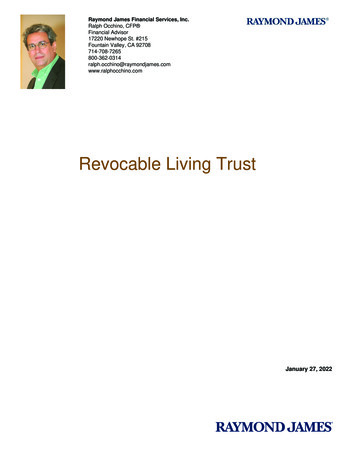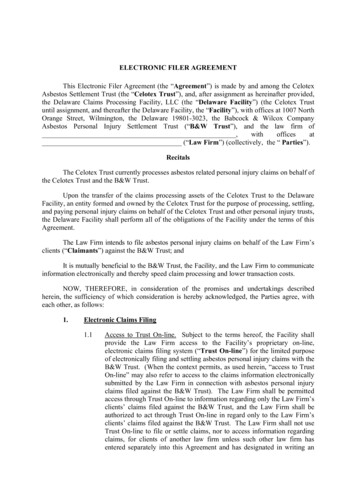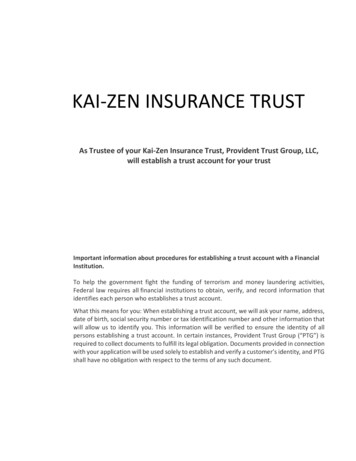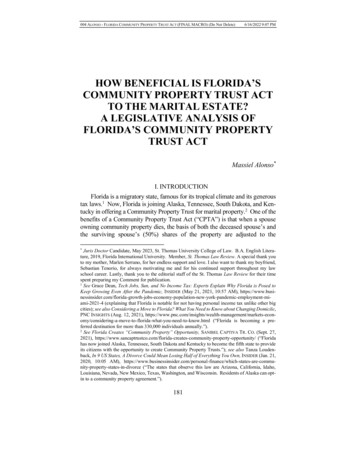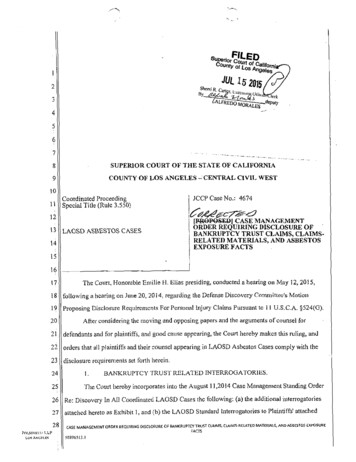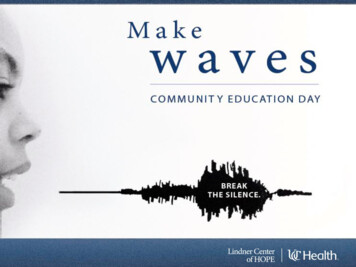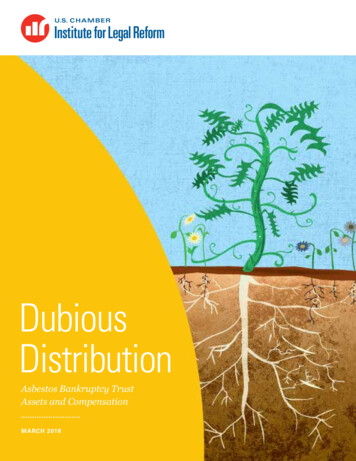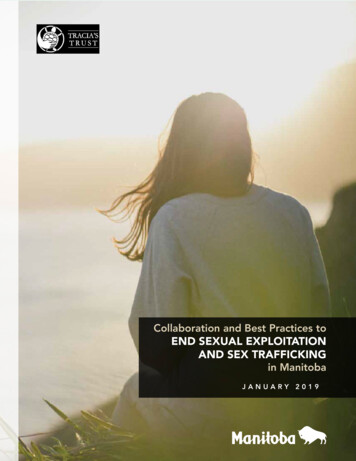
Transcription
Collaboration and Best Practices toEND SEXUAL EXPLOITATIONAND SEX TRAFFICKINGin ManitobaJANUARY 2019
COPYRIGHTCopyright Tracia’s Trust: Manitoba’s Strategy to Prevent Sexual Exploitation and Sex Trafficking.Manitoba Government. January 2019.Contents of this report may not be reproduced without permission in writing.Research, analysis, report content and graphic design were created by the staff from the Manitoba Families,Child and Family Services Division, Sexual Exploitation Unit.DEDICATIONThis report honours all of the experiential voices, people and organizations who make up Tracia’s Trust andwork in collaboration to end sex trafficking and sexual exploitation in ManitobaSweetgrass is a sacred medicine. Seven single strands of grass make up eachsection of a braid. Each single strand represents a human being and threesections of the braid are the body, mind and spirit. Just like a strand of hair,each strand of sweetgrass is beautiful, smells lovely, and is unique. But, like astrand of hair, each individual strand is more fragile on its own. Once braided,those same strands are strong and unified.— Teaching Shared by Elders, Original Source UnknownThis is how Tracia’s Trust works. Just like a braid of sweetgrass,each strand of the Tracia’s Trust strategy is comprised of differentperspectives, strengths and ideas. But, like a braid, thereis one primary path up the middle. This is where all the strandsintersect, making it strong and unified.2
ACKNOWLEDGEMENTSThe research team gratefully acknowledges the invaluable collaborations and participation of dozen ofcolleagues, Manitoba’s 12 Tracia’s Trust regional teams to prevent sexual exploitation, survivors andpersons with lived experience, front-line service providers, law enforcements, non-governmentalorganizations, community groups, social workers, and practitioners across the province who shared theirhelpful insights and experiences through focus groups, or who sat on internal or external advisory groups.Particular thanks go to a number of individuals who provided guidance to this research; Dr. Brittany Luby,Dr. Jennifer Frain, Dr. Karen Busby, Dr. Marlyn Bennett, Elder Mae Louise Campbell, Elder BelindaVandenbroeck, Elder Dolores Gosselin, Emily Richard, Hennes Doltze, Jamie Goulet, Jane Runner,Jennifer Richardson, Josie Hill, Karen Harper, Kim Trossel, Laurie Mackenzie, Mitch Bourbonniere, RachelJones, Sunshine Forest and Dianna Bussey.“With relationship comes respect.What helps young people,Indigenous or not, is to find your role, have adult allies to helpyou find that role, fulfill your responsibilities within that role,and then be of service to the community.If we all did that .to me that would be reconciliation in action.”1Truth and Reconciliation Commission of Canada ReportThe research team would like to acknowledge that thisresearch took place on Treaty 1 Territory, the traditional landsof the Anishinabe (Ojibway), Ininew (Cree), Oji-Cree, Dene andDakota, and in the heart of the homeland of the Métis Nation.i
LIST OF ACRONYMSCFS – Child and Family ServicesCFSIS – Child and Family Services Information SystemCIC – Child in CareFASD – Fetal Alcohol Spectrum DisorderHRV – High Risk VictimLGBT2SQ 2 – Lesbian, Gay, Bisexual, Transgender, Two-Spirited and Queer POP – Prostitution Offender ProgramRCMP – Royal Canadian Mounted PoliceWPS – Winnipeg Police ServiceWRHA – Winnipeg Regional Health AuthoritySEY – Sexually Exploited YouthSTR – StreetReachDEFINITIONSChild Sexual Exploitation: As defined by Manitoba’s Child and Family Services Standard 1.3.5, child sexualexploitation is “the act of coercing, luring or engaging a child, under the age of 18, into a sexual act andinvolvement in the sex trade or pornography, with or without the child’s consent, in exchange for money,drugs, shelter, food, protection or other necessities.” Child sexual exploitation of an individual under theage of 18 is clearly defined and interpreted as child abuse.Human Trafficking: The definition of human trafficking adhered to for the purposes of this study is from theUnited Nations Palermo Protocol to Prevent, Suppress and Punish Trafficking in Persons, especially Womenand Children, adopted by the United Nations General Assembly in 2000 and ratified by Canada in 2002.According to Article 3 of the Palermo Protocol, three interdependent elements – act, means and purpose– must be cumulatively present to constitute a trafficking offence.Prostitution: This report’s case study on the Winnipeg Prostitution Offender Program adheres to the legaldefinition of prostitution, which is defined in the Criminal Code of Canada as obtaining sexual services forconsideration. It is illegal to purchase sexual services, to communicate in public with the intention of buyingor selling sex, to advertise the sale of others’ sexual services, or to sell sex in any area where a person under18 years of age may reasonably be expected to be present.Sex Trades and the Sex War Debate: Participants in this study self-identified distinct sex trades: 1) the sextrade in which individuals are exploited or trafficked, 2) the sex trade in which adult sex workers have freechoice. The sex war debate refers to the polarized views, beliefs, and philosophies related to prostitution,which in turn, have led to heated public debate related to sex trafficking and sexual exploitation.SWOT Analysis: This refers to the strengths, weaknesses, opportunities and threats (SWOT) analyticalframework commonly used in strategic planning, mapping exercises and research analysis, including in thisreport.Tracia’s Trust (the strategy): This refers to Tracia’s Trust: Manitoba’s Strategy to Prevent Sexual Exploitationand Sex Trafficking, which was formally launched by the Manitoba government in 2002.ii
PARTICIPATING ORGANIZATIONSSincere thanks go to the following organizations who contributed to this report, either by participating in afocus group, by sharing general information or statistics, or by providing overall feedback andrecommendations:1. Action Therapy29. Manitoba Justice2.Advisory Council of Knowledge Keepers forTracia’s Trust330. Manitoba Status of Women3.All Nations Coordinated Response Network32. Métis Child and Family Services Authority4.Assembly of Manitoba Chiefs5.Blue Thunderbird Family Care Inc.33. Nanaandawewigamig – First Nations Health andSocial Secretariat of Manitoba6.Brandon Westman Team Against SexualExploitation34. New Directions for Children, Youth, Adults andFamilies7.Canadian Centre for Child Protection8.Dauphin/Parkland South – Committee Advocatingfor the Removal of Sexual Exploitation35. Norway House/Cross Lake – Sexual ExploitationRegional Team9.Dream Catchers10. Elizabeth Fry Society of Manitoba11. Experiential Advisory Committee12. First Nations of Northern Manitoba Child andFamily Services Authority13. Flin Flon/North Region – Sexual Exploitation Team14. General Child and Family Services Authority15. Immigrant and Refugee Community Organizationof Manitoba Inc.16. Ka Ni Kanichihk Inc.17. Klinic Community Health18. Knowles Centre Inc.19. Macdonald Youth Services20. Ma Mawi Wi Chi Itata Centre Inc.21. Manitoba Community Living disABILITY Services22. Manitoba Child and Family Services Division23. Manitoba Department of Education31. Marymound Inc.36. Pine Falls/North Eastman – Sexual ExploitationRegional Team37. Portage La Prairie/Central – Sexual ExploitationRegional Team38. Project Neecheewam Inc.: Resources for Childrenand Youth39. Resource Assistance for Youth Inc.40. Royal Canadian Mounted Police41. Sage House42. Salvation Army43. Snowflake Place for Children and Youth44. Southeast Child Sexual Exploitation PreventionCommittee45. Southern First Nations Network of Care46. StreetReach47. Swan River/Parkland North – Swan ValleyCommittee for the Elimination of Sexual Abuse48. Thompson/Northern – Sexual ExploitationAwareness Team24. Manitoba Employment and Income AssistanceProgram49. Trafficked Persons Response Network25. Manitoba Families51. Winnipeg Grandmothers Protecting Our Children26. Manitoba FASD Life’s Journey52. Winnipeg Police Services27. Manitoba Healthy Child53. Winnipeg Sexually Exploited Youth CommunityCoalition28. Manitoba Labour and Regulatory Services50. Transition Education and Resources for Females54. Winnipeg Regional Health Authority“Never doubt that a small group of thoughtful, committed citizenscan change the world. Indeed, it’s the only thing that ever has.”Margaret Meadiii
iv
TABLE OF CONTENTSCopyright and Dedication.p. iAcknowledgements.p. iiDefinitions.p. iiiParticipating Organizations.p. ivExecutive Summary. p. 2Executive Summary – FRENCH. p. 6Introduction. p. 10About Tracia’s Trust and the Sexual Exploitation Unit. p. 12Sexual Exploitation and Sex Trafficking in Manitoba. p. 15Research Goals and Purposes. p. 17Methodology. p. 18Limitations. p. 20Experiential Voices. p. 23Research Findings. p. 24Conclusion. p. 84End notes. p. 85Bibliography. p. 90Appendix A and B – Quantitative Data Categories and Focus Group Questions. p. 94Appendix C and D – List of Case Studies and List of Tables. p. 95Appendix E – List of Figures. p. 96“Eagle teaches us that it is okay to combine wisdom and courage— it is okay to be wise enough to know that a change needs to bemade . and then finding the courage to execute the change.”Unknown Author, Indigenous Teaching1
EXECUTIVE SUMMARYThis research project, titled Collaboration and Best Practices to End Sexual Exploitation and Sex Traffickingin Manitoba, is the first of its kind undertaken by Manitoba’s Sexual Exploitation Unit. It contributes to thegrowing body of work on evidence-based best practices to prevent sexual exploitation and sex traffickingin Canada.Guided by mixed-method research, the project’s goal is to inform Tracia’s Trust: Manitoba’s Strategy toPrevent Sexual Exploitation and Sex Trafficking (the strategy). The project analyzes new data to furtherunderstand sexual exploitation and sex trafficking in Manitoba. It also provides vision and direction abouthow to translate objectives into results for vulnerable Manitobans.To date, the diverse responses to prevent sex trafficking and sexual exploitation locally and globally haveled to changes such as: stronger anti-trafficking legislation new ways of identifying and supporting exploited persons increasing public awarenessHowever, as the United Nations Inter-agency Coordination Group against Trafficking in Persons has noted,“these advancements have occurred in the absence of rigorous empirical evidence evaluating the extent towhich [these responses] have [contributed or not contributed] to the achievement of planned goals.”4In many cases, it is not clear if aims and outcomes have been achieved, or if results are being measuredtogether. Counter trafficking responses in Canada and globally have often lacked a theory of change andprogram logic, because there has not been systematic investment in measuring, evaluating, and learningpractices, tools that are essential to counter trafficking and counter exploitation work. Given much of thiswork is relatively new and in its infancy, it has often lacked a logical framework that is evidence-based.5Since 2002, the Manitoba government has led counter sexual exploitation efforts, consulted nationally, anddemonstrated leadership and innovation in this area. In 2002, Manitoba launched Canada’s first provincialstrategy to prevent sexual exploitation. This strategy is now known as Tracia’s Trust in honour of TraciaOwen, who tragically died of suicide after she was sexually exploited. Every year, Tracia’s Trust providesapproximately 10 million to fund initiatives in the areas of prevention, intervention, legislation,coordination, research and evaluation.Seeking to be evidence based, Manitoba has gathered data from multiple sources and internal databases.This research initiative allows the Manitoba government to develop a program logic and assess the resultsof Manitoba’s work in this area. Its findings also inform and contribute to the government’s child welfaretransformation agenda.Fifty-four organizations contributed to the report, either by participating in a focus group, by sharinggeneral information or statistics, or by providing overall feedback and recommendations.The overall objectives of the full report are as follows: provide evidence-based insights on current investigations, co-occurring phenomena, system gaps,placement dynamics, offenders, and the incidence of sexual exploitation in Manitoba identify important trends inform training formalize emerging best practices inform policy developments, program evaluations and accountability inform future research, capacity building programs, resources and projects inform a proactive, upstream approach6 serve as an education, prevention and awareness tool for the general public2
inform the establishment of a program logic for Tracia’s Trust guide evidence-based measuring, evaluating, and learning for the strategyThe report contains key findings based on quantitative, qualitative and case study analysis related to thefollowing topics: the causes of sexual exploitation existing materials, training and education needs self-care engaging with men and boys as buyers, bystanders and victims information and research needs current strengths, weaknesses, opportunities and threats related to the strategy how things can be improved or done differently at the provincial level the link between social media and sexual exploitation what focus group participants wished to stress or addThe report concludes with specific next steps to drive assessment and measurement to enhance services forsexually exploited children, youth and adults in Manitoba.The report’s findings highlight Manitoba’s leadership in developing an innovative, evidence-based, sexualexploitation counter strategy, in collaboration with experiential voices, partner departments, agencies andthe community.KEY FINDINGSThis report identifies opportunities to use and expand existing resources, and develop and implement newpolicies and procedures via strategic partnerships related to: online sexual exploitation and sex trafficking provisions for sexually exploited or sex trafficked adults and youth who turn 18, including those onextensions of care substance abuse treatment, in collaboration with the future development of the Manitoba MentalHealth and Addictions Strategy, specific to the methamphetamine crisis for this population,particularly children and youth reform of current specialized placements and resources to address co-occurring factors forsexually exploited or sex trafficked persons consultation to capture and be inclusive and respectful of all of the diverse urban and rural voicesand stakeholders under Tracia’s Trust3
OPPORTUNITIES MOVING FORWARDManitoba Families coordinates the implementation of the strategy via its Sexual Exploitation Unit, incollaboration with partnering government departments (e.g., Education, Employment and IncomeAssistance, Health, Labour, Justice and Status of Women), agencies, the community and non-governmentalorganizations leading specific initiatives under the strategy.In the course of this report, dozens of stakeholders were consulted. Front-line service providers, experientialvoices, community members, Elders, law enforcement, and government officials provided valuablefeedback, insights, and suggestions. In light of the report findings, the research team recommends therepurposing of existing funding and the implementation of policies and procedures in collaboration withpartnering government departments, agencies, the community and non-governmental organizations in theareas that follow.CHILD AND FAMILY SERVICES Continue general education and training curriculum development in this area. Continue training in the area of sexual abuse investigation. Strengthen agencies responses to sexually exploited youth outside of traditional work hours. Share report findings to inform and contribute to the government’s child welfare transformationplan. This includes youth-adult transition planning, placements that better meet the needs of thispopulation, implementing best practice service delivery, and addressing and equipping serviceproviders to respond to co-occurring phenomena (e.g., substance abuse, cognitive vulnerability,and mental health). Implement ongoing program evaluations that measure change and effectiveness over time forinitiatives under Tracia’s Trust (e.g., every two to three years).COMMUNITY AND NON-GOVERNMENTAL ORGANIZATION PARTNERSHIPS Continue data collection, tracking and analysis. Continue to include and integrate diverse voices to ensure diversity, equity, respectful conduct,cultural safety and inclusivity. Continue to strengthen partnership with law enforcement and subject matter experts to preventfuture trauma for exploited children, youth, adults and their families. Work in collaboration with Elders and experiential voices, children, youth, adults and families.INTERDEPARTMENTAL (MANITOBA GOVERNMENT) Identify opportunities to enhance access to a range of addictions treatment models and servicesfor this population. Create opportunities to identify new adult services for this population. Consult with the regional health authorities on best practices related to trauma informed care andharm reduction.7 Continue interdepartmental collaboration. Identify and enhance policies and procedures in youth justice services that would help preventfuture trauma and support restorative justice. Strengthen collaboration between Manitoba Families and Manitoba Justice in the areas ofoffender accountability and child safety.4
SEXUAL EXPLOITATION UNIT Develop a code of conduct and self-care policies for Tracia’s Trust, to prevent burnout and ensurediversity, respectful conduct, equity and inclusivity. Continue to support and integrate the diverse voices of Elders and people with lived experiencein the sex trades. Continue data collection, tracking and analysis. Continue ongoing research and collaboration on best practices and key topics and trends. Continue ongoing capacity building in partnership with Tracia’s Trust regional teams to increasepublic education and awareness. Explore and create new partnerships in rural and non-urban areas relevant to this population. Conduct consultation on online counter-exploitation strategies in collaboration withkey stakeholders. Conduct consultation with law enforcement and experts in the area of offender accountabilityand safety. Strengthen strategic planning in support of the Tracia Trust strategy. Continue training in the areas of sexual exploitation and sexual abuse investigation.BE BOLD ENOUGH TO SPEAK THE TRUTH“All of us, every person has the ability to be creative, you havebeen given a very special gift . Think of something different,do something different, put yourself in their moccasins . whenthere’s these gangs, and they are so smart . that’s what we haveto do, all of us, how to get these kids to come to whatever kindof program they’re trying to create to get their attention so wehave to become more creative, in today’s crazy world with all ofthe Internet and other crazy stuff that is happening, we haveto get more creative to wake ourselves up . because wonderfulthings happen to you when you create something new that works.”Teaching from Indigenous Elder during Research Focus Group5
SOMMAIRECe projet de recherche, intitulé Collaboration and Best Practices to End Sexual Exploitation and SexTrafficking in Manitoba (collaboration et pratiques exemplaires pour mettre fin à l’exploitation sexuelleet au trafic sexuel au Manitoba), est le premier projet du genre à être entrepris par l’Unité de lutte contrel’exploitation sexuelle du Manitoba. Il s’ajoute à l’ensemble des travaux sur les pratiques exemplairesfondées sur des données probantes réalisés pour prévenir l’exploitation sexuelle et le trafic sexuelau Canada.Le projet, qui s’appuie sur des méthodes de recherche mixtes, a pour but d’éclairer le Tracia’s Trust :Stratégie manitobaine visant les enfants et les jeunes menacés ou victimes d’exploitation sexuelle. Ilconsiste à analyser de nouvelles données pour mieux comprendre l’exploitation sexuelle et le trafic sexuelau Manitoba. Il propose aussi une vision et une orientation quant à la façon de traduire en résultats lesobjectifs poursuivis relativement aux Manitobains vulnérables.Jusqu’à maintenant, les diverses interventions visant la prévention de l’exploitation sexuelle et du traficsexuel à l’échelle régionale et internationale ont conduit aux changements suivants : renforcement des lois en matière de lutte contre le trafic sexuel; nouvelles façons de localiser et de soutenir les personnes exploitées; plus grande sensibilisation du public.Comme le fait remarquer l’United Nations Inter-agency Coordination Group against Trafficking in Persons,« ces progrès ont été réalisés en l’absence de données empiriques rigoureuses permettant d’évaluer dansquelle mesure [ces interventions] ont [contribué ou non] à la réalisation des buts prévus. »4Dans de nombreux cas, on ne sait pas exactement si l’on a atteint les buts et les résultats escomptés ou siles résultats sont mesurés. Souvent, les mesures prises pour lutter contre le trafic sexuel au Canada et àl’étranger ne sont pas fondées sur une théorie du changement et une logique de programme en raison del’absence d’investissement systématique dans les méthodes de mesure, d’évaluation et d’apprentissage,qui sont des outils essentiels à la lutte contre l’exploitation et le trafic. Comme ce travail est assez nouveauet qu’il en est à l’étape de début, il est fréquent qu’il ne s’inscrive pas dans un cadre logique fondé sur desdonnées probantes.5Depuis 2002, le gouvernement du Manitoba a mené plusieurs projets de lutte contre l’exploitation sexuelle,tenu des consultations nationales et fait montre de leadership et d’innovation dans ce domaine. En 2002,le Manitoba a lancé la première initiative provinciale canadienne de prévention de l’exploitation sexuelle.Cette stratégie porte le nom de Tracia’s Trust en l’honneur de Tracia Owen, qui s’est suicidée de façontragique après avoir été victime d’exploitation sexuelle. Chaque année, le Tracia’s Trust fournit environ10 millions de dollars pour financer des projets dans les domaines de la prévention, de l’intervention,de la législation, de la coordination, de la recherche et de l’évaluation.Désireux de fonder ses initiatives sur des données probantes, le Manitoba a recueilli des données auprèsde nombreuses sources et bases de données internes. Ce projet de recherche permet au gouvernement duManitoba d’élaborer une logique de programme et d’évaluer les résultats de son travail dans ce domaine.Ses constatations guident le programme de transformation du bien être de l’enfance du gouvernementet y contribuent.Cinquante quatre organismes ont contribué au rapport, soit en prenant part à un groupe de discussion, soiten partageant des renseignements généraux ou des statistiques, soit en fournissant une rétroactiongénérale et des recommandations.Le rapport complet vise les objectifs généraux suivants : f ournir des connaissances fondées sur des données probantes sur les enquêtes courantes, lesphénomènes concomitants, les lacunes du système, la dynamique du placement, les contrevenantset l’incidence de l’exploitation sexuelle au Manitoba;6
dégager les tendances importantes; guider la formation; officialiser les pratiques exemplaires émergentes; guider l’élaboration des politiques, l’évaluation de programme et la responsabilisation; g uider les recherches, les programmes de développement de la capacité, les ressourceset les projets futurs; é clairer une approche en amont proactive;servir d’outil d’éducation, de prévention et desensibilisation du grand public; guider l’établissement d’une logique de programme pour le Tracia’s Trust; g uider les activités de mesure, d’évaluation et d’apprentissage fondées sur des donnéesprobantes pour la stratégie.Le rapport contient des constatations importantes fondées sur l’analyse d’études de cas, des analysesquantitatives et des analyses qualitatives portant sur les sujets suivants : les causes de l’exploitation sexuelle; les besoins existants en matière de formation, de matériel et d’éducation; l’autogestion de la santé; les contacts avec les hommes et les garçons comme acheteurs, observateurs et victimes; les besoins en matière d’information et de recherche; les forces, les faiblesses, les possibilités et les menaces courantes associées à la stratégie; comment améliorer la situation ou procéder différemment à l’échelle provinciale; le lien entre les médias sociaux et l’exploitation sexuelle; points que les participants au groupe de discussion désiraient souligner ou ajouter.Le rapport propose en conclusion les prochaines étapes requises pour réaliser le travail d’évaluationet de mesure afin d’améliorer les services à l’intention des enfants, des jeunes et des adultes victimesd’exploitation sexuelle au Manitoba.Le rapport met en évidence le leadership du Manitoba en matière d’élaboration d’une stratégie de luttecontre l’exploitation sexuelle novatrice et axée sur des données probantes, en collaboration avec despersonnes ayant des acquis expérientiels, les ministères partenaires, des organismes et la collectivité.PRINCIPALES CONSTATATIONSCe rapport fait état de possibilités d’utiliser et d’étendre les ressources existantes; et d’élaborer et demettre en œuvre de nouvelles politiques et procédures au moyen de partenariats stratégiques dans lesdomaines suivants : exploitation sexuelle et trafic sexuel en ligne; dispositions relatives aux adultes et aux jeunes victimes d’exploitation sexuelle ou de trafic sexuelqui parviennent à l’âge de 18 ans, y compris celles qui se rapportent à la prolongation des soins; traitement pour les toxicomanies, en plus de la collaboration à l’élaboration future de la Stratégieen matière de santé mentale et de lutte contre les dépendances du Manitoba, dans le casparticulier de la crise de méthamphétamine pour cette population, notamment les enfantset les jeunes;7
réforme des ressources et des placements spécialisés actuels pour prendre en considération lesfacteurs concomitants qui interviennent dans le cas des personnes victimes d’exploitation sexuelleou de trafic sexuel; consultation pour entendre la diversité des personnes concernées dans les collectivités urbaineset rurales, les inclure et les traiter avec respect, et les intervenants dans le cadre du Tracia’s Trust.POSSIBILITÉS D’ALLER DE L’AVANTFamilles Manitoba coordonne la mise en œuvre de la stratégie par l’entremise de son Unité de luttecontre l’exploitation sexuelle, en collaboration avec les ministères partenaires (p. ex. Éducation, Aide àl’emploi et au revenu, Santé, Travail, Justice et Condition féminine), des organismes, la collectivité et desorganismes non gouvernementaux menant certains projets en vertu de la stratégie.Ce rapport fait suite à la consultation de douzaines d’intervenants. Fournisseurs de services de premièreligne, personnes ayant des acquis expérientiels, membres de la collectivité, Aînés autochtones, organismesd’application de la loi et représentants du gouvernement ont fait part de leurs suggestions, de leurs pointsde vue et de leurs commentaires très utiles. À la lumière des constatations du rapport, l’équipe derecherche recommande d’adapter le financement existant et de mettre en œuvre des politiques et desprocédures en collaboration avec les ministères, les organismes, la collectivité et les organismes nongouv
growing body of work on evidence-based best practices to prevent sexual exploitation and sex trafficking in Canada. Guided by mixed-method research, the project's goal is to inform Tracia's Trust: Manitoba's Strategy to . Prevent Sexual Exploitation and Sex Trafficking (the strategy). The project analyzes new data to further
